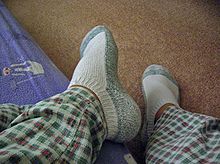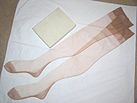Sock: Difference between revisions
Undid revision 302893180 by Buttskeezicks (talk) rvv |
|||
| Line 17: | Line 17: | ||
== History == |
== History == |
||
[[File:Islamic sock.jpg|thumb|12th century cotton sock, found in [[Egypt]]. The knitter of this sock started work at the toe and then worked up towards the leg. The heel was made last and then attached to loops formed while knitting the leg. This ingenious practice allowed the heel to be easily replaced when it wore out]] |
[[File:Islamic sock.jpg|thumb|12th century cotton sock, found in [[Egypt]]. The knitter of this sock started work at the toe and then worked up towards the leg. The heel was made last and then attached to loops formed while knitting the leg. This ingenious practice allowed the heel to be easily replaced when it wore out]] |
||
Socks have evolved over the centuries from the earliest models which were made from |
Socks have evolved over the centuries from the earliest models which were made from baby skins gathered up and tied around the ankles.<ref>[http://www.holeproof.com.au/About-Holeproof/Study-Centre/History-of-Socks.asp History of Socks]</ref> In the [[8th century BC]], the [[Ancient Greece|Ancient Greek]]s wore socks from matted animal hair for warmth. The [[Ancient Rome|Romans]] also wrapped their feet with leather or woven fabrics. By the [[5th century]] AD, socks called ‘puttees’ were worn by holy people in [[Europe]] to symbolise purity. By 1,000 AD, socks became a symbol of wealth among the nobility. From the [[16th century]] onwards, an ornamental design on the ankle or side of a sock has been called a clock.<ref>[http://www.merriam-webster.com/dictionary/clock%5B3%5D clock<sup>3</sup>]</ref> |
||
The invention of a [[knitting machine]] in 1589 meant that socks could be knitted six times faster than by hand. Nonetheless, knitting machines and hand knitters worked side by side until 1800. |
The invention of a [[knitting machine]] in 1589 meant that socks could be knitted six times faster than by hand. Nonetheless, knitting machines and hand knitters worked side by side until 1800. |
||
Revision as of 05:19, 19 July 2009


A sock is a knitted or woven type of hosiery garment for enclosing the human foot. Socks are designed to:
- ease chafing between the foot and footwear
- protect footwear by absorbing perspiration and dead skin lost from the foot
- provide comfort
- be fashionable
- keep the feet warm
Sock is also the term given to the layer of leather or other material covering the insole of a shoe. When only part of the insole is covered, leaving the forepart visible, this is known as a half-sock.[1] The average foot has 250,000 sweat glands, and the average pair gives off about half a pint (almost 250 mL) of perspiration per day.[2] Socks help to absorb this sweat and draw it to areas where air can wick the perspiration away.[3] In cold environments, socks help to retain/remove the moisture given off by one's feet, decreasing the risk of frostbite.[4][5] Its name may have originated by the shoes worn by Roman comic actors called soccus in Latin. It was a slipper and fitted loosely so it could be taken off quickly.[citation needed]
History

Socks have evolved over the centuries from the earliest models which were made from baby skins gathered up and tied around the ankles.[6] In the 8th century BC, the Ancient Greeks wore socks from matted animal hair for warmth. The Romans also wrapped their feet with leather or woven fabrics. By the 5th century AD, socks called ‘puttees’ were worn by holy people in Europe to symbolise purity. By 1,000 AD, socks became a symbol of wealth among the nobility. From the 16th century onwards, an ornamental design on the ankle or side of a sock has been called a clock.[7]
The invention of a knitting machine in 1589 meant that socks could be knitted six times faster than by hand. Nonetheless, knitting machines and hand knitters worked side by side until 1800.
The next revolution in sock production was the introduction of nylon in 1938. Until then socks were commonly made from silk, cotton and wool. Nylon was the start of blending two or more yarns in the production of socks, a process that still continues.
Fabrication
Socks can be created from a wide variety of materials. Some of these materials are cotton, wool, nylon, acrylic, polyester, olefin, polypropylene, or spandex.[8] To get an increased level of softness other materials that might be used during the process can be silk, linen, cashmere, or mohair.[9] The color variety of sock choices can be any color that the designers intend to make the sock upon its creation. Sock 'coloring' can come in a wide range of colors. Sometimes art is also put onto socks to increase their appearance. Different sports generally brandish different sock colors and there are also sometimes each sock will have a different color (for some significance or another). Colored socks may be a key part of the uniforms for sports, allowing players teams to be distinguished when only their legs are clearly visible.
Styles

Socks are manufactured in a variety of lengths. Bare or ankle socks extend to the ankle or lower and are often worn casually or for athletic use. Bare socks are designed to create the look of "bare feet" when worn with shoes. Knee-high socks are sometimes associated with formal dress or as being part of a uniform, such as in sports or as part of a school's dress code. Over-the-knee socks or socks that extend higher (thigh-high socks) are traditionally considered female garments.
There is a national knee high sock day which is June 11. National knee high sock day started in 1942.A toe sock encases each toe individually the same way a finger is encased in a glove, while other socks have one compartment for the big toe and one for the rest, like a mitten – most notably Japanese tabi. Both of these allow one to wear flip-flops with the socks. Leg warmers, which are not typically socks, are commonly replaced with socks in northern regions of Scandinavia due to the cold climate.
Sock sizes

Sock sizes can vary from 8.5 - 11.5 [10]. Sock lengths vary, from ankle-high to thigh level and much in between.
In the UK, a sock's size is the similar to the person's shoe size; for example, a foot that has a shoe size of 9 would require a sock sized 8-10.
In some parts of the world socks are sized differently than shoes. The chart below gives size equivalences, although there is no indication as to which of the numerous sizing systems it represents:
| Sock size | Men's shoe size | Women's shoe size |
|---|---|---|
| 9-11 | 3-1/2 to 8-1/2 | 4 to 10 |
| 10-13 | 6-1/2 to 12 | 8-1/2 to 12-1/2 |
Other less common sock sizes are 10-15, 13-15, and 13-16.
See also
- Stocking
- Beoseon (traditional Korean socks)
- Tabi (traditional Japanese socks)
- Toe socks
- Sock puppet

